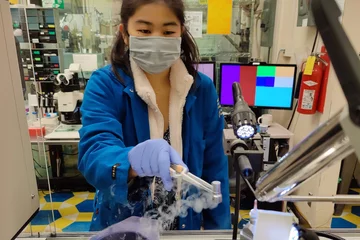Certified Athletic Trainer - Sports Medicine Career
Medical Expert Interview

Sports Medicine Careers
Sports medicine is an area of healthcare focused on athletes. A sports medicine practice covers myriad medical and physiological goals and concerns that can and do impact athletes.
Such an expansive goal demands a commensurate breadth of practitioners and professionals. That’s why the field of sports medicine encompasses a dynamic range of job types and career opportunities.
The article below explores certified athletic training. Additional sports medicine career roles include:
- Orthopedic Surgeon
- Physical Therapist
- Sports Neurologist
- Sports Cardiologist
- Sports Psychologist
- Sports Nutritionist / Registered Dietician
- Team Physician
Sports Medicine Career Overview
Header image courtesy of UCLA Athletics. Pictured: Jordan Wooler. Photo by: Ross Turteltaub.
Meet Marc Reichling, Director of Sports Medicine at UCLA
Marc Reichling is a certified athletic trainer and director of sports medicine at UCLA.

Growing up, Marc was an athlete through and through. He ran track, played football and hockey, and even did a little swimming. Around the time he began applying to universities and considering future careers, he learned that a friend worked as an athletic trainer.
The job title made his ears perk up, and not only because the role would allow him to honor his love for sports.
“I wanted to find something where I was helping people,” Marc explains. “I wasn't quite interested in business. I had some interest in medicine, but I didn’t necessarily want to become a doctor.”
The idea of being an athletic trainer, on the other hand, interested him greatly. He explored his curiosity by doing observation hours with an athletic trainer at a local high school.
“I absolutely fell in love with Athletic Training immediately,” Marc says. “It involved being around sports and impacting athletes every day. It felt like the perfect combination of elements I wanted in a career.”
What Does a Certified Athletic Trainer Do?
Certified athletic trainers are clinicians who work closely with athletes to help them feel and perform their best. They help athletes stay healthy, manage injuries, implement injury prevention strategies, and improve performance.
Athletic Trainers interact with the athletes under their guidance every day. They’re often an athlete’s first touchpoint for any medical or performance-related question or concern.
Marc finds his daily interactions with student athletes personally meaningful. Truly getting to know the athletes under his care inspires him to go above and beyond in his training.
Marc likens a certified athletic trainer’s role with a sports team to a nurse’s role in any clinic or medical practice. A nurse’s face is often the first and last a patient sees during a medical appointment or hospital stay.
“I think what’s unique about the athletic trainer is that you see individual patients and whole teams on a daily basis,” he says. “In a high school setting, you're with that athlete from freshman to senior year. You get to develop relationships, make connections, and support them through their ups and downs.”
Developing customized treatment and rehabilitation plans is another cornerstone of a certified athletic trainer’s work. Marc says many people outside the sports medicine world assume Athletic Trainers follow only plans and instructions from a team physician or physical therapist.
“Athletic trainers don’t only follow treatment plans. They’re educated, trained, and qualified to develop and implement them as well.”
Certified athletic trainers also attend practices and games with teams to provide emergency care when necessary.
These sports medicine professionals are not only champions of each athlete’s individual performance. They also help manage the collective wellness of the entire team. They keep players and staff informed about an injured player’s recovery, interface with other members of the athlete’s care team, and work with coaches to mitigate the negative effects one injury has on the entire team.
How to Become a Certified Athletic Trainer
It takes around 4 to 6 years to become a certified athletic trainer:
- Earn a bachelor’s degree.
- Estimated time required: 4 years
- Earn a Master’s degree from a college or university accredited by the Commission on Accreditation of Athletic Training Education (CAATE).
- Estimated time required: 4 years
- Meet all certification, licensing, and registration requirements for the state in which they plan to train.
- Estimated time required: 1 - 6 months
- Athletic trainers seeking certification should thoroughly check their state’s requirements. However, many states require certification from the Board of Certification for the Athletic Trainer (BOC), which is contingent on passing the BOC exam.
Optional steps:
Secure additional certifications for niche athletic training focus areas.
- Estimated time required: Varies highly per individual and experience level.
- For example, Marc holds specialty certifications in…
- Functional Movement Systems (FMS)
- Selective Functional Movement Assessment (SFMA)
- Dynamic Neuromuscular Stabilization (DNS)
- Corrective Exercise Specialist (CES)
- Applied Functional Science (CAFS)
To maintain their certification, athletic trainers must adhere to ongoing requirements—such as continuing education—and standards of practice mandated by their certification board.
Where can aspiring athletic trainers find additional information about education, training, and certification?
- National Athletic Trainers Association (NATA)
- Board of Certification for the Athletic Trainer (BOC)
- Commission on Accreditation of Athletic Training Education (CAATE)
Advice for Aspiring Athletic Trainers
Marc tells aspiring athletic trainers to think about two major questions:
- What do you want to get out of working as a certified athletic trainer?
- Ten years from now, what do you want your day-to-day life to look like?
He urges anyone considering becoming an athletic trainer to think deeply about why they’re called to this line of work and whether or not that passion feels strong enough to last through the hard times. An individual’s physical needs are as unique as their personalities—and sometimes as unpredictable as the weather. Injuries don’t happen only during games and other scheduled events.
Meeting these varied needs requires care, attention, flexibility, and a true interest in getting to know each client. That’s what Marc loves most about his work—building relationships with talented athletes who are also amazing humans.
“Making an impact” was always his answer to the first question he asks aspiring trainers. Because his work provides him with that, he can easily handle minor headaches around shifting schedules and working long hours.
The meaning he finds in his work outweighs the challenges. He finds fulfillment in making an impact—by helping athletes achieve their physical, athletic, and personal goals.
“That's the biggest thing—whether or not someone finds fulfillment in their career,” Marc says.
“Someone may have all the skills and knowledge in the world, but if they’re not fulfilled or even satisfied, their clients and patients may never benefit from their talents.”
In addition to having a deep interest in the work and the people, Marc says candidates best prepared to handle the demands of athletic training possess the following core characteristics:
- A people-centered mentality. Certified athletic trainers work with people all day, every day.
- A desire and motivation to learn constantly, as there’s always a new finding or technique to hear about in the dynamic field of sports medicine.
- An appreciation for consistency and routine.
Quick Facts: Certified Athletic Trainer
What are the core job responsibilities of a certified athletic trainer?
- Assess, treat, and help prevent athletic injuries.
- Create training and treatment plans to support athletes’ performance goals and physical health.
- Provide urgent and emergency care as needed.
Where can a certified athletic trainer find employment?
Certified athletic trainers may find employment opportunities in a variety of different settings, including:
- Professional athletic teams and organizations
- Olympic teams and organizations
- Athletic events and tournaments (per diem)
- School athletic teams of all levels
- Sports rehabilitation centers
- Sports medicine clinics
- Healthcare facilities (clinics, hospitals, and private practices)
- Gyms/training facilities
- Corporate, military, and first-response environments
How much does a certified athletic trainer make?
- Estimated annual salary range: $50,000 - $80,000
Athletic trainers practicing in the United States make around $40,000 - $80,000 annually, according to recent data from the U.S. Bureau of Labor Statistics. Earning potential varies widely depending on the trainer’s location and industry of work, education, and certifications.



